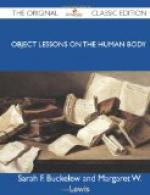8. I must not breathe impure air, because impure air makes bad blood, and bad blood makes poor bones.
9. The body of every person is changing all the time, because the skin, flesh, and bones are always wearing out, and the blood is always repairing and building them again.
* * * * *
QUESTIONS FOR THE FORMULA.
1. Tell about the skull.
2. Tell about the spine.
3. Tell about the ribs.
4. Tell about the shoulder blades.
5. Tell about the collar bones.
6. Tell about the difference between the bones of old people and those of children.
7. Of what are your bones made?
8. If you wish your bones to be strong, why should you not breathe impure air?
9. What have you learned about the change which is always taking place in the body?
* * * * *
[Illustration: THE JOINTS OF THE SKULL.]
* * * * *
A little girl was looking at some pictures of ladies in fashionable dresses. While admiring the beautiful styles and bright colors of the garments, she pointed to the waist of one, and exclaimed, “That means trouble.” The waist was too small for a grown person, and could only have been made so by tight-lacing. The child had been taught that dresses, corsets, coats, vests, bands, or anything fastened tightly around the waist, press upon the ribs and crowd them out of place, preventing the heart, lungs, and other inside organs from working as they should, causing headache, dyspepsia, shortness of breath, and often ending in some incurable disease, so she knew that tight clothing means trouble to the wearer.
[Illustration: FIG. 1. Deformed by tight-lacing.]
[Illustration: FIG. 2. A natural, well-shaped chest.]
* * * * *
QUESTIONS ON THE DESCRIPTION OF THE BONES.
Point to the skull.
Of what is it made?—“Several bones united together.”
How are the skull bones united?—“Like two saws with their toothed edges hooked into each other.”
What do you mean by toothed?—“Having points, like teeth.”
What covers the skull?—“Flesh, skin, and hair.”
Of what use is the skull?—“It protects the brain.”
What is the brain?—“That part of my body in which the thinking is done.”
Where is the spine?—“It extends from the base of my skull behind, down the middle of my back.”
What do you mean by extends?—“Goes from.”
What do you mean by base?—“The lower part of anything.”
Of what is the spine made?—“Of about twenty-four short bones, with cartilage between them.”
What is cartilage?—“An elastic substance, harder than flesh, but softer than bone.”
How are the bones of the spine placed?—“They are piled one upon the other.”




